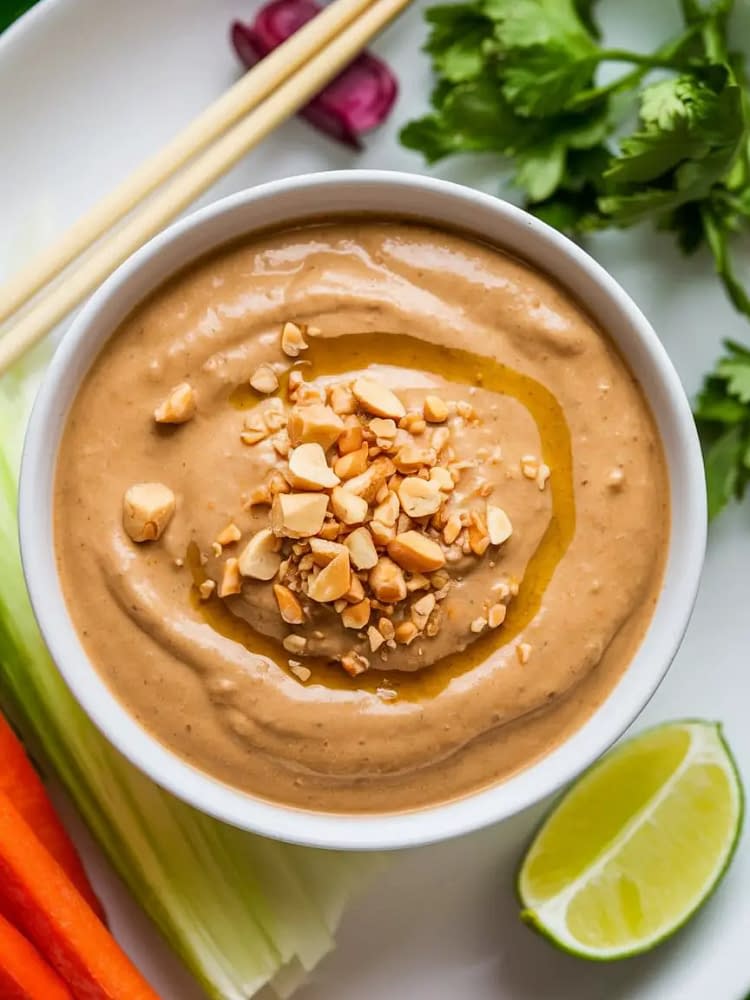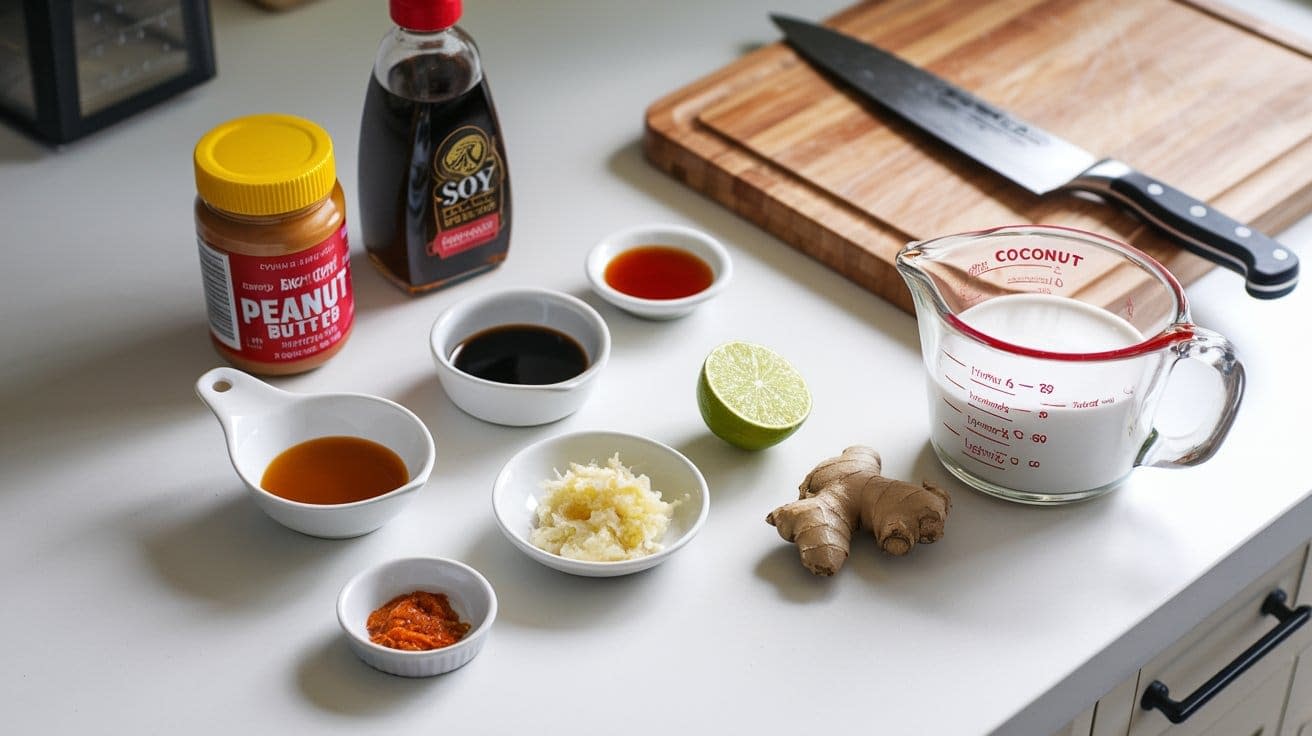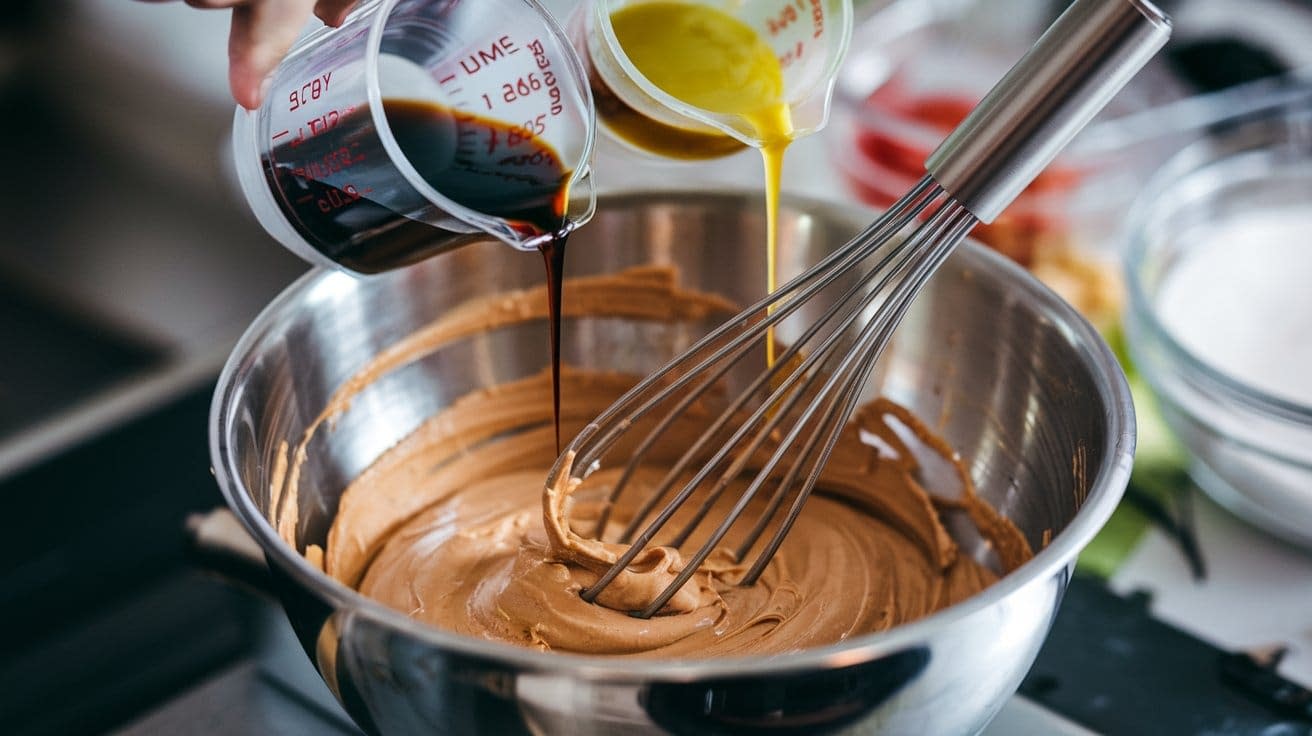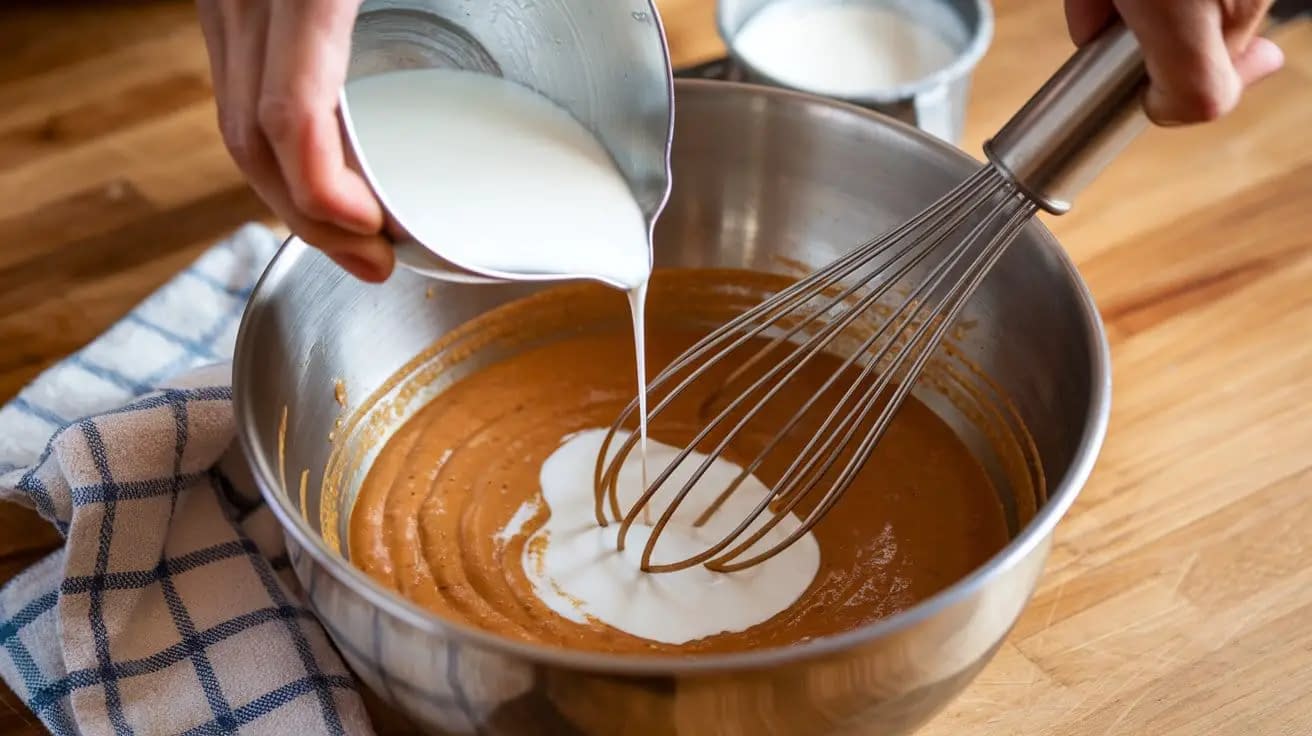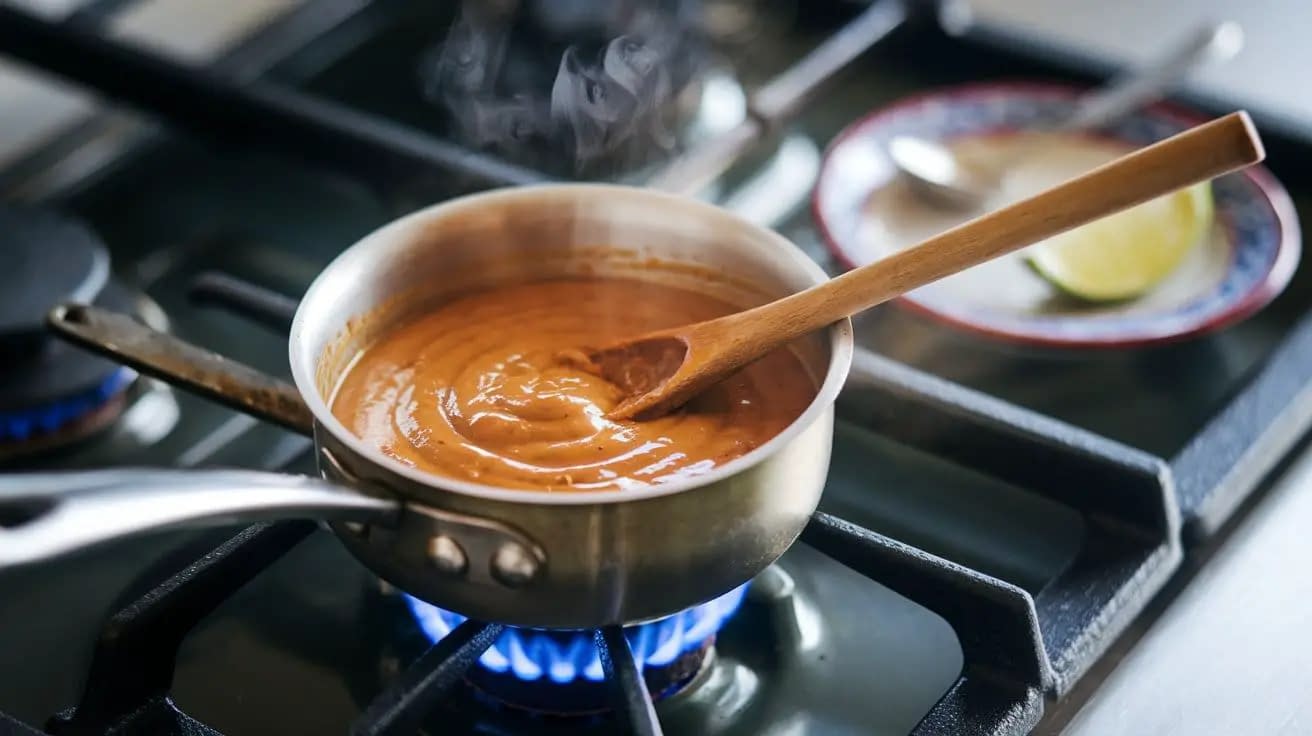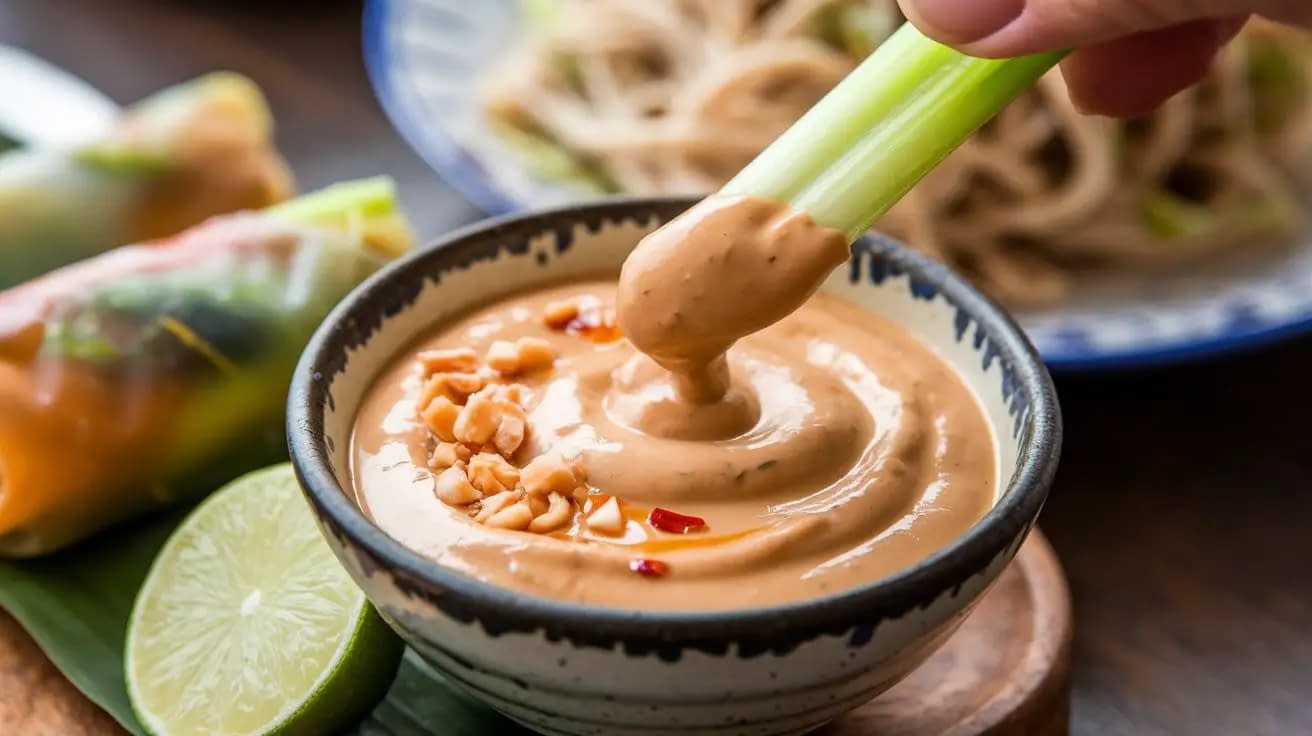Thai Peanut Sauce is one of the most beloved condiments in Thai cuisine, celebrated for its rich, nutty, and slightly spicy profile. This versatile sauce pairs perfectly with satay skewers, fresh spring rolls, noodles, salads, and even grilled meats. The balance of flavors—sweet, salty, tangy, and spicy—makes it an irresistible addition to a wide range of dishes.
In this blog post, we’ll dive deep into everything you need to know about Thai Peanut Sauce, from its traditional ingredients to preparation techniques, variations, and serving suggestions. Whether you’re a home cook looking to elevate your meals or a food enthusiast eager to explore authentic Thai flavors, this guide will help you master the perfect peanut sauce.
What is Thai Peanut Sauce?
Thai Peanut Sauce, also known as “Satay Sauce”, is a creamy and flavorful dipping sauce originating from Southeast Asia. While it is commonly associated with Thai cuisine, variations of peanut-based sauces can also be found in Indonesian and Malaysian dishes.
The sauce is typically made with peanut butter or ground peanuts, coconut milk, soy sauce, lime juice, and a mix of aromatic spices. Some versions include a hint of sweetness from palm sugar or honey, while others incorporate a touch of heat from chili flakes or sriracha.
Ingredients for the Perfect Thai Peanut Sauce
Creating the perfect Thai Peanut Sauce starts with high-quality ingredients. Here’s a breakdown of what you’ll need:
Core Ingredients:
- Peanut Butter (or Roasted Peanuts): The heart of the sauce, providing its rich and nutty base. Opt for natural, unsweetened peanut butter or grind roasted peanuts for an authentic texture.
- Coconut Milk: Adds creaminess and a mild sweetness that balances the bold flavors. Full-fat coconut milk works best.
- Soy Sauce: Contributes umami depth and saltiness. You can use tamari for a gluten-free option.
- Lime Juice: A splash of acidity to cut through the richness and enhance the flavor profile.
- Garlic: Freshly minced garlic adds a punch of aromatic goodness.
- Ginger: Provides a subtle warmth and depth to the sauce. Freshly grated ginger is recommended.
- Palm Sugar or Honey: A touch of sweetness to balance the salty and tangy components. Brown sugar can be used as an alternative.
- Chili Flakes or Sriracha: For heat! Adjust the spice level according to your preference.
- Fish Sauce (Optional): Adds an authentic umami taste, but can be omitted for a vegan version.
- Water or Broth: Helps to achieve the desired consistency.
Step-by-Step Instructions: How to Make Thai Peanut Sauce
Step 1: Gather and Prepare Ingredients
Before starting, measure and prepare all your ingredients. If using whole peanuts, grind them into a fine paste using a food processor.
Step 2: Heat the Base
- In a small saucepan, heat a tablespoon of oil over medium heat.
- Add minced garlic and grated ginger, sautéing for about 30 seconds until fragrant.
Step 3: Combine the Ingredients
- Lower the heat and stir in peanut butter, coconut milk, soy sauce, lime juice, and palm sugar.
- Stir continuously to prevent the mixture from sticking to the pan.
Step 4: Adjust the Consistency
- If the sauce is too thick, gradually add water or broth until you reach your desired consistency.
- For a thicker dipping sauce, keep it as is; for a drizzle-friendly sauce, add more liquid.
Step 5: Add Spice and Flavor Enhancements
- Stir in chili flakes or sriracha for heat.
- Taste and adjust with additional lime juice, soy sauce, or sweetness if needed.
Step 6: Simmer and Serve
- Let the sauce simmer for 2–3 minutes to allow the flavors to meld.
- Remove from heat and let it cool slightly before serving.
Tips for the Best Thai Peanut Sauce
✔ Use fresh ingredients – Fresh garlic, ginger, and lime juice enhance the sauce’s depth of flavor.
✔ Adjust consistency as needed – Add more coconut milk or water for a thinner sauce, or let it simmer longer for a thicker version.
✔ Customize the spice level – Start with a small amount of chili and gradually increase to your desired heat level.
✔ Make it ahead of time – The flavors develop even more if allowed to sit for a few hours before serving.
Variations: Customizing Your Thai Peanut Sauce
???? Vegan-Friendly Version: Simply omit fish sauce and use tamari instead of soy sauce.
???? Low-Carb/Keto: Use a sugar substitute like monk fruit sweetener instead of palm sugar.
???? Extra Creamy: Add a bit more coconut milk for a smoother texture.
???? Nut-Free Alternative: Use sunflower seed butter instead of peanut butter for an allergy-friendly option.
Serving Suggestions: What to Pair with Thai Peanut Sauce
This versatile sauce complements a variety of dishes:
Dipping Sauce: Perfect for spring rolls, satay skewers, dumplings, and vegetable sticks.
Salad Dressing: Drizzle over Thai salads or grain bowls for an extra boost of flavor.
Noodle Sauce: Toss with rice noodles or soba noodles for a delicious meal.
Wraps & Sandwiches: Spread on lettuce wraps, pita sandwiches, or rice paper rolls.
Grilled Meats & Tofu: Serve as a glaze for grilled chicken, shrimp, tofu, or tempeh.
How to Store Thai Peanut Sauce
To keep your homemade peanut sauce fresh:
- Store in an airtight container in the refrigerator for up to one week.
- Reheat gently over low heat, adding a splash of water if it thickens too much.
- For longer storage, freeze in small portions and thaw when needed.
Conclusion: Elevate Your Meals with Thai Peanut Sauce
Thai Peanut Sauce is a simple yet incredibly flavorful addition to any dish. Whether you’re using it as a dip, dressing, or marinade, its rich and nutty taste brings out the best in both vegetarian and meat-based meals. With its easy preparation and customizable ingredients, you can adjust it to suit your dietary preferences and spice tolerance.
Try making this delicious sauce at home, and don’t be afraid to experiment with flavors! Let us know in the comments how you like to enjoy your Thai Peanut Sauce. Happy cooking!
Thai Peanut Sauce Recipe
This creamy and flavorful Thai Peanut Sauce is the perfect balance of sweet, savory, and spicy. Made with peanut butter, soy sauce, lime juice, and a touch of spice, it pairs beautifully with noodles, grilled meats, spring rolls, and stir-fries. This quick and easy homemade sauce is better than takeout and ready in minutes!
Ingredients
For the Sauce:
Instructions
Gather Ingredients
Measure all ingredients and have them ready for a smooth cooking process. Use fresh lime juice and garlic for the best flavor.
Mix the Base Ingredients
In a medium bowl, whisk together peanut butter, soy sauce, rice vinegar, lime juice, honey (or maple syrup), grated ginger, and minced garlic until well combined.
Adjust the Consistency
Gradually add coconut milk or water, whisking continuously, until the sauce reaches your desired consistency—smooth and pourable but still rich.
Heat for Enhanced Flavor
Transfer the sauce to a small saucepan and heat over low heat for 1-2 minutes, stirring constantly. This helps blend flavors and slightly thickens the sauce.
Final Touch & Serve
Remove from heat, stir in sesame oil (if using), and garnish with crushed peanuts. Serve warm or at room temperature.
Nutrition Facts
Servings 4
- Amount Per Serving
- Calories 267.74kcal
- % Daily Value *
- Total Fat 22.29g35%
- Saturated Fat 7.07g36%
- Trans Fat 0.02g
- Sodium 464.26mg20%
- Potassium 291.94mg9%
- Total Carbohydrate 12.45g5%
- Dietary Fiber 1.9g8%
- Sugars 6.63g
- Protein 8.84g18%
- Vitamin A 0.12 IU
- Vitamin C 2.03 mg
- Calcium 31.2 mg
- Iron 1.42 mg
- Vitamin E 3.14 IU
- Vitamin K 0.22 mcg
- Thiamin 0.07 mg
- Riboflavin 0.14 mg
- Niacin 4.81 mg
- Vitamin B6 0.17 mg
- Folate 37.73 mcg
- Phosphorus 149.88 mg
- Magnesium 74.22 mg
- Zinc 1.14 mg
* Percent Daily Values are based on a 2,000 calorie diet. Your daily value may be higher or lower depending on your calorie needs.
Note
- Storage: Store in an airtight container in the refrigerator for up to a week. Reheat with a splash of water or coconut milk to thin if needed.
- Spice Level: Adjust sriracha or chili flakes based on your heat preference.
- Substitutions: Swap peanut butter for almond or cashew butter if needed.

